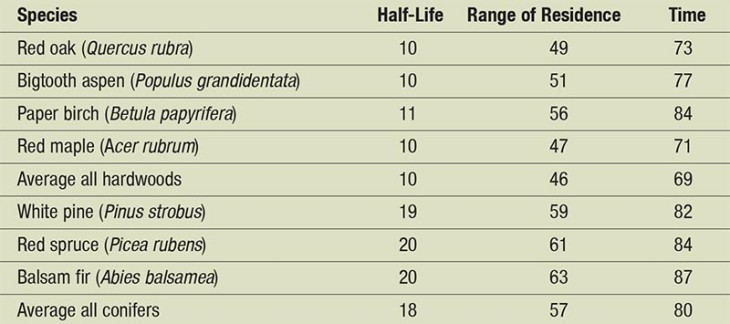Say you want to know how long a fallen tree takes to completely decompose. You could walk into the woods, cut a tree down, and return to check on it, say, once a month, for 10, 50, maybe even 100 years. Given enough time, you’d see the tree progress through the stages of decomposition until its remains were indistinguishable from the surrounding soil.
Of course, this approach would only tell you about one specific tree in one specific spot with a unique set of environmental conditions. And most of us don’t have the stick-to-itiveness (or lifespan) for this sort of thing.
Fortunately, scientists are looking into this for us. Over the last few years, a group of researchers from the U.S. Forest Service and the University of Minnesota have worked to find a faster, more generalizable method. By monitoring thousands of downed logs in forests across the U.S., they collected data that was used to build a mathematical model that shows how long different tree species take to break down.
Heading up this project is Christopher Woodall, a research forester with the Forest Service’s Northern Research Station in St. Paul, Minnesota. In woods stretching from Minnesota to Maine in the north and from Louisiana to Georgia in the south, technicians catalogued every downed log they found. They ranked each log on a scale of one to five, from freshly fallen to badly decomposed, and then returned to the same forests five years later to revisit and reassess. Using these figures, the researchers were able to create a model of decay for 36 different species of trees. “Some people said it couldn’t be done,” said Woodall, “but we did it.”
The computer model calculates that the “residence times” (how long a tree will take to completely decompose) for conifer species range from 57 to 124 years, while hardwood species are typically around on the forest floor for 46 to 71 years. Warmer, more humid environments promote faster decay than cooler, drier climates.
Besides tree type and climate conditions, the biggest factor in how long a piece of wood takes to decompose is length, with shorter log segments breaking down faster. Woodall speculates that this is because logs that are broken off at both ends offer more opportunities for fungi and microorganisms to colonize their insides. “If somebody cut off one of your arms, you’d have one potential infection point, but if they cut off both your arms, you’d have two infection points,” he said. “You’d have twice the probability of getting gangrene.”
The model can be used to predict how the process of decomposition in forests might change due to global warming. It can also be used to calculate the carbon stocks in a forest, so a forester could, for example, estimate how many years dead wood left by logging operations will take to break down, depending on size, site class, and the area of the country. “It’s good to inform people who manage forests about what effect their management actions will have on the residency of biomass and carbon that they leave behind,” said Woodall.
Decay by the Numbers
Here’s a sampling of the findings from the research in raw numbers. Half-life is defined as the number of years it takes a piece of downed woody debris to lose 50 percent of its initial biomass. Because decay rates are not linear, the residence times of downed woody debris don’t always correlate directly to the half-life. The study used a complex formula to arrive at residence times because, as the researchers noted, the length of time that downed woody debris resides in a forest “is not necessarily marked by a distinct end point.”




Discussion *